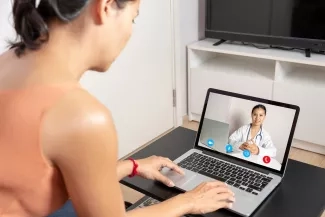Why It Matters

Like many people during the COVID-19 pandemic, I recently had my first telemedicine primary care visit. My experience as a physician-patient may be unique to physician-patients — or even just unique to me — but it provided me with some insights as health care quickly transitions to virtual health care delivery.
For several weeks, I had been experiencing a new set of symptoms. While I recognized that they could be related to stress, I also knew they could indicate one or more treatable medical issues. I held a differential diagnosis in my head and knew the steps I would take to evaluate a patient who presented to me with similar symptoms.
I decided I would only seek direct care under very dire circumstances because I am living with a family member who is at extremely high risk for serious illness (or even death) if they developed COVID-19. I needed a second opinion, so I reached out to my primary care provider and scheduled a telemedicine visit by phone.
My provider started the conversation with a preamble that went something like this: Given the current context, we can’t practice medicine as we normally would and so we are forced to practice substandard clinical care. I will talk you through what we would normally do, tell you what we can do, and tell you your choices.
I agree that we must do the best we can with what we have, but is telemedicine necessarily “substandard” care? I would invite us to use this time of rapid conversion to virtual care as an opportunity to revive traditional “arts” and leverage all possible assets:
- Make full use of a patient’s clinical history — I learned in medical school that patient history determines over 80 percent of diagnoses. If telemedicine invites us to rely even more heavily on the history to help with the diagnosis, is that a bad thing?
- Focus on what matters most to the patient — I discovered the value of asking patients what they thought was wrong with them when I was in clinical practice. Many times, their insights proved valuable and close to the mark. Patients were often seeking reassurance, so understanding their biggest fear often made my job simpler. It was typically the easiest item on the differential diagnosis to cross off. It’s highly unlikely your symptoms are cancer. If you had cancer, we would most likely also see other symptoms, like x, y, and z. Because you don’t have those symptoms, a cancer diagnosis is unlikely.
- Understand the benefits of watchful waiting — Waiting for the clinical picture to evolve can be a valid option. It is often easily implemented via telemedicine and helps avoid medical overuse. The current risk of coronavirus exposure — for patients, family, and staff — and the continued critical shortage of PPE also compel us to be more selective about ordering scans and blood draws.
- Promote self-care for symptom management — There are almost always actions patients can take to help manage their symptoms. The impact of attention to sleep, nutrition, exercise, quiet reflection, etc., are too often undervalued by our medical culture. We now have a chance to recognize and leverage the benefits of self-care.
- Build trusting relationships — Just as we should during face-to-face clinical encounters, clinicians can listen fully, demonstrate respect, focus on what matters, share our thinking, and work together on a mutually agreed upon plan during telemedicine interactions. Building a trusting bond with good communication can be very satisfying for both patient and provider.
Overall, my experience of the virtual visit was mixed. In my case, what mattered most to me was getting a second opinion (beyond my own). I needed to weigh this against risk of coronavirus exposure. The phone call with my provider achieved that. I decided my symptoms were probably triggered by stress and chose to wait and watch.
The tone of the encounter, however, left me wondering if we’re doing telemedicine a disservice if we automatically assume it represents putting quality care “on hold” until physical distancing restrictions are lifted. During this period of transition, let's take time to learn more about using telemedicine as a tool to redesign care for the better.
Trissa Torres, MD, MSPH, FACPM, is IHI's Chief Population Health and Portfolio Development Officer.
You may also be interested in:
Telemedicine: Ensuring Safe, Equitable, Person-Centered Virtual Care
